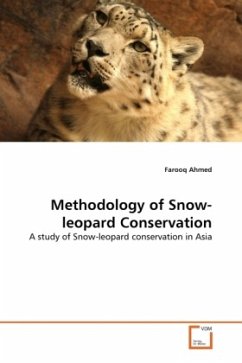The snow leopard has long, thick smoky gray fur with dark rosettes and spots, and a very long thick tail. Weighing up to 75 kg (165 lb), it has large, well-cushioned paws, a strong chest, and short forelimbs that enable it to scale outcroppings high on cliffs. Further adaptations for high-altitude life include long hair with dense, woolly under fur and an enlarged nasal cavity. It has been reported to leap as far as 15 m (about 50'). Throughout its range, the snow leopard is mostly associated with steep, dry, rocky terrain with shrub or grassland vegetation. It is generally found at elevations between 3000 - 4500 m (9800 - 14,800'). The snow leopard is an opportunistic predator. Its most common prey includes wild sheep and goats, but it also eats marmots, pikas, hares and game birds (chukor partridge and snowcocks), as well as domestic sheep and goats.








